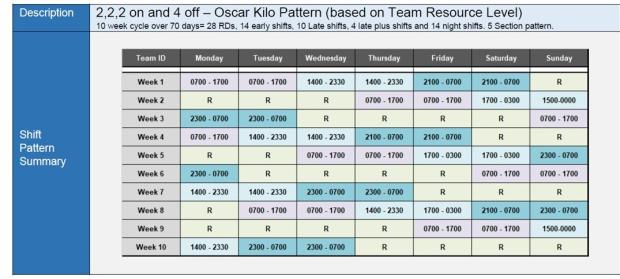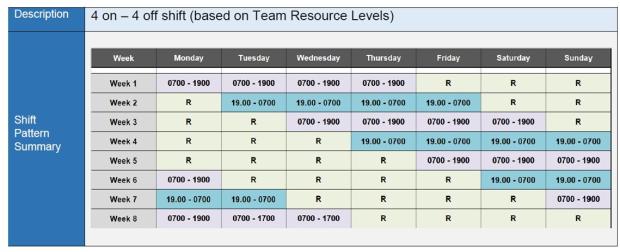Question
Overtime for 2025-2026 is estimated at 34million with 18million allocated for local policing. I've asked previously why a 4:4 shift pattern cannot be afforded to staff rather than the 6:4 shift pattern currently in place. I've been advised it's due to cost. Can you tell me;
1. What would the cost be to move to a 4:4 shift pattern from the 6:4 pattern?
2. How have you worked that out?
3. Do you have a broader cost benefit analysis for both shift patterns that you can provide to me?
Answer
When considering shift pattern changes, PSNI must bear in mind that only the 8-hour shift pattern can be lawfully imposed on officers, owing to Working Time Regulations. Any change of shift pattern other than this is required by regulations to have the support of 75% of the workforce before it can be implemented.
At present Local Policing Teams operate a 10-hour variable shift pattern, which is run across five sections. Please see Table A below for more detail:
Table A – 10-hour variable shift pattern

A 6:4 shift pattern, sometimes referred to as the ‘Oscar Kilo pattern’, was piloted in two Districts for 6 months last year, beginning in summer 2024. Please see Table B below for further detail:
Table B – 6:4 shift pattern

The results of the pilot showed insufficient officer support to change to the 6:4 pattern and therefore the 10-hour variable pattern was retained, and remains the current shift pattern for the service.
Details of the 4:4 12-hour shift pattern are given below in Table C.
Table C – 4:4 shift pattern

The PSNI’s decision not to implement the 4:4 shift pattern is not solely based on the costs involved, although this is a factor. Local Policing moved away from the 4:4 or ‘four on, four off’ shift pattern based on the recommendation made in the 2005/06 “Best Value Review”. This review probed extensively into various police shift patterns, touching on their impact on operational demand, officer welfare, and efficiency. The then current 4:4 system, popular among officers for its long rest periods (192 days off per year), was assessed as being: inflexible; not matching demand peaks; causing fatigue; lacking built-in briefing/debriefing time and having no section overlap to assist in administrative duties for frontline officers
In addition, the review noted that the 4:4 pattern required more officers to cover shifts due to inefficiencies, leading to continuity issues, as officers may not work the same shift on the same day for up to 56 days. The ‘four off’ element, which came after two night shifts, was also highlighted as not being supportive of victim support and community engagement.
Alternative shift patterns examined in the review included variable 10-hour, variable 12-hour, variable 8-hour, and standard 8-hour shifts. The preferred recommendation in this review was the 10-hour variable shift pattern that is currently worked. This pattern was identified as being better aligned to staffing with demand, reduced overtime costs, improved compliance with Working Time Regulations, lower fatigue risk, and included some briefing time. As predicted in the review, a move from the 4:4 pattern was not favoured by many officers, owing to the 10-hour variable pattern having fewer rest days and more weekend/late shifts. Overall, the review advocated strongly around moving from rigid 12-hour shifts to more flexible, demand-led variable shifts to improve resource utilisation, officer wellbeing, and service delivery. The 10-hour shift pattern was eventually implemented across response policing, now known as Local Policing Teams (LPT).
In addition, the review identified that operating the then current 4:4 12-hour system involved substantial overtime costs, estimated at £24 million per year. This high cost was due to the mismatch between staffing levels and operational demand, leading to excessive overtime payments to cover peak times. The 12-hour system also required more officers (163) to run the shifts, compared to some alternative patterns, further contributing to higher personnel costs.
While cost is not the only factor in determining a suitable shift pattern for frontline policing, it has to be considered. Key examples around the increased costs of any 12-hour pattern that operates across four sections includes the following:
The 4:4 pattern does not create an overlapping of shifts, e.g. during peak times across the nighttime economy, two sections are on-duty on the current shift pattern. This aligns resource with demand. Without this overlap in shifts, any increase in resource to deal with this demand would have to be paid in overtime, Modified Rest Days (MRDs) or abstractions from other areas.
School of Instructions for frontline officers, essential for Continuous Professional Development, would have to be covered with overtime.
Overtime rates are significantly higher when significant deployments are required, due to the limited flexibility in the shift. E.g., you cannot extend a shift for any period of time to cover other demands, as this would create a shift in excess of the 12 hours worked.
The 12-hour shift pattern creates Appended Rest Days (ARDs), which are additional leave days for officers. Covering these rest days with existing resource numbers would mean an overtime spend.
While cost is only one consideration, the following elements must also be taken into account when contemplating any 12-hour shift pattern:
Potential impact on levels of officer fatigue and sleep disruption. Research indicates 4:4 has a significant impact on officer wellbeing.
Longer shifts may impact productivity and impact on officers with longer commutes. The average commute time for officers in some Districts is 54 minutes each way.
Concern over lack of file/investigation overlapping time, and difficulties maintaining victim/suspect contact, given four rest day periods and with the pattern ending on two night shifts.
25% of resource on at any time, with no overlap for peak demand times.
Our assessment is that, based on the current resourcing pressures faced across Local Policing Teams, in order to maintain an operationally effective level of resource across peak demand times, the same financial impact identified in the “Best Value Review” would exist, and even be compounded by the reduction in resource and the gaps currently existing within Local Policing Teams. It has always been acknowledged that the current 10-hour variable pattern relies on overtime to operate effectively, and this overtime could be spent to deliver a 12-hour 4 section pattern, but the wider disadvantages of a 12-hour pattern need to be key considerations.
It is important to highlight that An Garda Síochána recently moved frontline officers from a 12-hour pattern to a 10-hour variable pattern. This process received significant media coverage, with An Garda Síochána indicating that the 12-hour pattern was too costly and meant less Garda working hours overall.
The “Best Value Review” and a recent paper on “shift pattern considerations” is available for viewing if more information is required.
Dr Kate Laverty